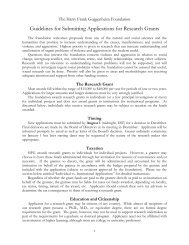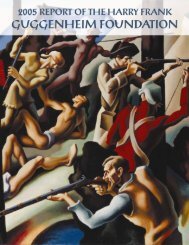Small Arms and Light Weapons - Harry Frank Guggenheim ...
Small Arms and Light Weapons - Harry Frank Guggenheim ...
Small Arms and Light Weapons - Harry Frank Guggenheim ...
- No tags were found...
Create successful ePaper yourself
Turn your PDF publications into a flip-book with our unique Google optimized e-Paper software.
the “dem<strong>and</strong> chain.” This conceptualization drawsattention to the mutuality of supply <strong>and</strong> dem<strong>and</strong><strong>and</strong> makes clear that dem<strong>and</strong>-oriented interventionscan be initiated at places other than the endusestage.Three Dimensions of Dem<strong>and</strong>Dem<strong>and</strong> for small arms <strong>and</strong> light weapons(SALW) arises from at least three sources: dem<strong>and</strong>by state security sectors, dem<strong>and</strong> by organizedarmed nonstate groups, <strong>and</strong> micro-level dem<strong>and</strong>exercised by individuals.dem<strong>and</strong> by armed forces <strong>and</strong>state institutionsWhile lack of reliable information on nationalholdings <strong>and</strong> procurement decisions limits clarityabout what drives dem<strong>and</strong> from this source, we doknow that the dem<strong>and</strong> for weapons for nationalarmed forces <strong>and</strong> police is capricious, <strong>and</strong> dependson such factors as defense policy, procurementcycles, budgetary constraints, force structures <strong>and</strong>mobilization strategy, <strong>and</strong> historical precedents.Efforts at increasing transparency in national holdingswill illuminate this dimension of dem<strong>and</strong>.dem<strong>and</strong> by armed nonstate groupsThis includes arming before <strong>and</strong> during conflict,perhaps keeping <strong>and</strong> replenishing stocks duringcease-fires, <strong>and</strong> the use of arsenals <strong>and</strong> the threat ofarming as a bargaining chip. A certain amount isalso understood about this dimension of dem<strong>and</strong>.The armed group is a central feature of most contemporaryarmed conflicts. Dem<strong>and</strong> is in part afunction of their financial resources, of comm<strong>and</strong><strong>and</strong> control structures, <strong>and</strong>, in particular, of accessto conflict goods. Also important are formal orinformal alliances between <strong>and</strong> among groups.dem<strong>and</strong> by individualsLess attention has been given to underst<strong>and</strong>ing athird dimension of dem<strong>and</strong>: those factors affectingmicro-level acquisition <strong>and</strong> ownership patternsamong civilians <strong>and</strong> groups in countries affected bylarge-scale societal violence. The remainder of thisarticle focuses principally on this category ofdem<strong>and</strong>ers. Failure to underst<strong>and</strong> this group risksthe misapplication of effort <strong>and</strong> resources in interventionstrategies.Donor governments, affected countries, the UNDepartment for Peacekeeping (DPKO), the WorldBank, the UN Development Programme (UNDP),<strong>and</strong> a host of nongovernmental organizations areinitiating a range of interventions, such asamnesties, disarmament, demobilisation <strong>and</strong> reintegration(DDR) programs, awareness <strong>and</strong> publicinformation campaigns, <strong>and</strong> weapons-for-developmentschemes that emphasize removal of weaponsfrom communities <strong>and</strong> armed actors. But many ofthese initiatives fail to capture the range of motivationsunderpinning weapons acquisition. Forexample, Kenyan herders, according to Weiss(2004), “often referred to coercive weapons collectionas 'forced upgrades' because the only net effectis the need to replace seized guns with the newermodels now available on the market.” Clearly,appraising dem<strong>and</strong> at this micro-level is vital toimproving the effectiveness of such programs <strong>and</strong>the design of others.Unpacking Micro-Level Dem<strong>and</strong>In recent years, modest levels of attention havebegun to be paid to underst<strong>and</strong>ing factors drivingmicro-level dem<strong>and</strong>. A number of quantitativestudies have highlighted the relationships betweenpoverty <strong>and</strong> income inequality (independent variables)<strong>and</strong> firearm homicide to explain dem<strong>and</strong> forweapons. 2 Criminologists <strong>and</strong> sociologists haveanalyzed the relationships among delinquency,repeat offenders, dysfunctional families, <strong>and</strong>weapons use. Qualitative research has drawn onthe experiences of community-based organizations<strong>and</strong> development agencies seeking to reduce levelsof armed violence in areas where they operate. A32




